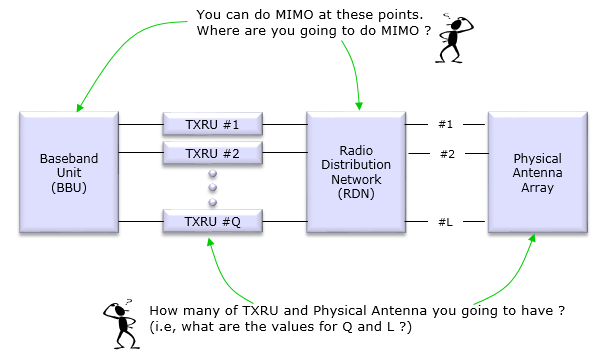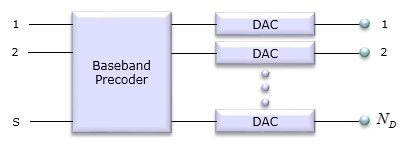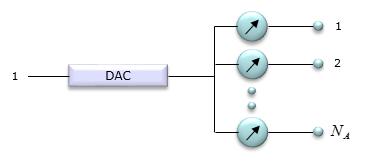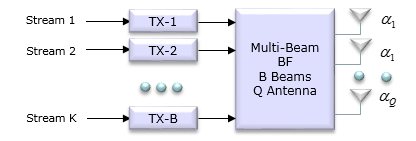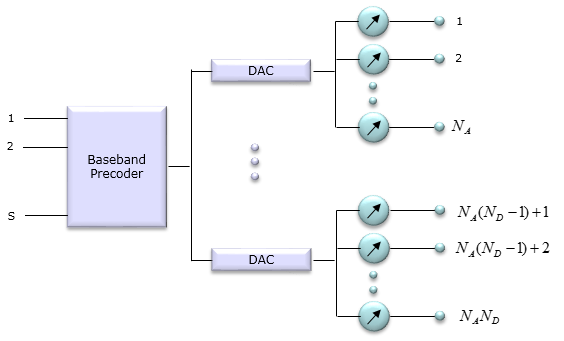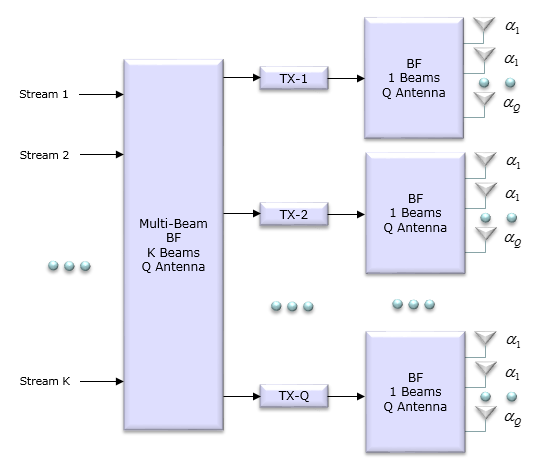|
|
||
|
As of now (Jun 2016), there is no determined technical details (or agreement) in 3GPP. However, from recent RAN1 meetings several technical proposals started coming out. So it might be a good time to start following up technical issues on Massive MIMO happening in 3GPP. Overall System ArchitectureFirst, let's think of overal system architecture of Massive MIMO. One example architecture proposed in R1-164708 ([1]) is as below. At the beginning of the process is a Baseband Unit and at the end is Physical Antenna Array. In between these two end points, there is special unit called Radio Distribution Network (RDN). The data out of the baseband unit is transferred to Radio Distribution Unit via a special interface called TXRU.
How / Where to implement the Massive MIMOBasically you can do something on MIMO at two level, one is at Baseband Unit level and the other is at RF level. And as you can easily guess, there can be possibility of combining the both. Depending on how/where to implement the MIMO, R1-164708 categorize three different types of implementation as summarized below. < Fullly Digital Architecture >In this architecture, MIMO/Beamforming is fully done by baseband unit (BBU) meaning MIMO is fully done purely mathematically. Practically RDN is not doing anything. However, we cannot add and remove the hardware while the system is working. So RDN will be still there even in Fully Digital Architecture. In this case, RDN sets a specifically fixed configuration and passes data from TXRU directly to Physical Antenna. Followings are some of the illustrations based on several different references. As you see, the terminology is a little bit different in different documents, but I left those terminology as in the original documents. It would be good chance to see a little bit different versions of presentation for a same concept. Illustration Based on R1-165179
Illustration Based on R1-165362
Several characteristics of this architecture are as follows :
< Fullly Analog/RF Architecture >In this architecture, there is no MIMO/Beamforming at BBU level. It is done by RDN which means it is done at RF level. Followings are some of the illustrations based on several different references. As you see, the terminology is a little bit different in different documents, but I left those terminology as in the original documents. It would be good chance to see a little bit different versions of presentation for a same concept. Illustration Based on R1-165179
Illustration Based on R1-165362
Several characteristics of this architecture are as follows :
< Hybrid Architecture >As name implies, in this architecture MIMO/Beamforming happens both at BBU and RDN. It doesn't mean that the exact the same MIMO/Beamforming happens twice. It means that the final effect of MIMO/Beamforming is splitted into two separate parts (BBU and RDN). Followings are some of the illustrations based on several different references. As you see, the terminology is a little bit different in different documents, but I left those terminology as in the original documents. It would be good chance to see a little bit different versions of presentation for a same concept. Illustration Based on R1-165179
Illustration Based on R1-165362 : Fully Connected Configuration
Illustration Based on R1-165362 : Sub Array Configuration
Reference :[1] R1-164708 : 3GPP TSG-RAN WG1 #85 - NR Massive MIMO Design Considerations [2] R1-165179 : 3GPP TSG-RAN WG1 #85 - Multi-Antenna Technology for NR Interface [3] R1-165362 : 3GPP TSG-RAN WG1 #85 - Multi-antenna Architectures and Implementation Issues in NR
|
||
